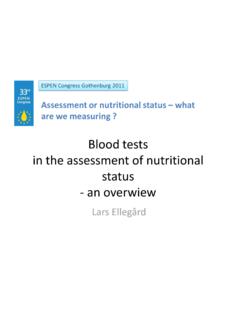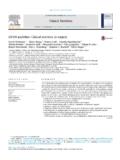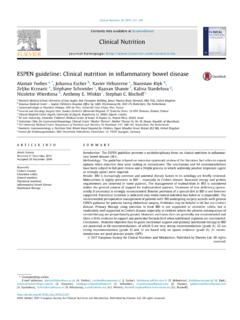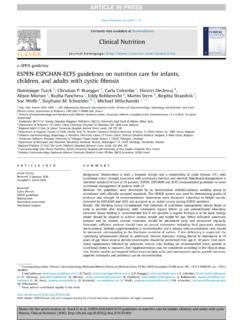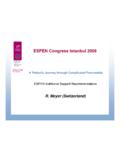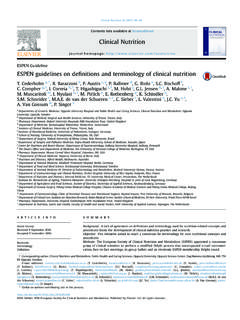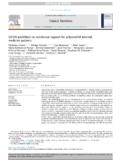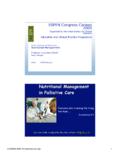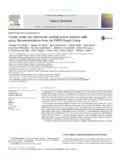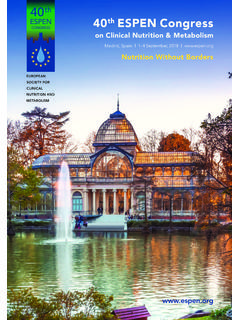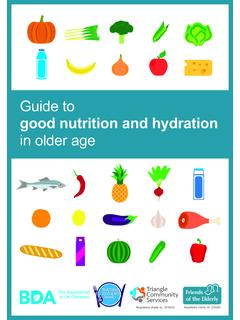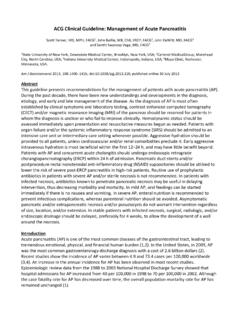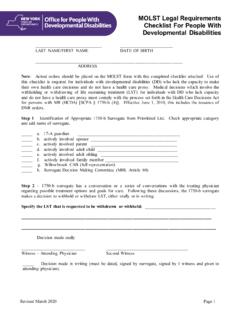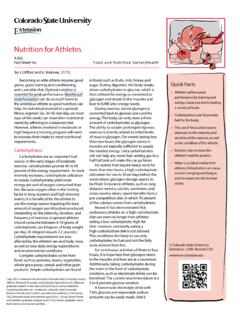Transcription of Espen Guideline on Ethical Aspects of Artificial Nutrition ...
1 E-SPEN guidelineESPEN Guideline on Ethical Aspects of Artificial Nutrition and hydrationChristiane Drumla,*, Peter E. Ballmerb, Wilfred Drumlc, Frank Oehmichend,Alan Shenkine, Pierre Singerf, Peter Soetersg, Arved Weimannh, Stephan C. BischoffiaUNESCO Chair on Bioethics at the Medical University of Vienna, Collections and History of MedicineeJosephinum, Medical University of Vienna,Waehringerstrasse 25, A-1090 Vienna, AustriabDepartment of Medicine, Kantonsspital Winterthur, Brauerstrasse 15, Postfach 834, 8401 Winterthur, SwitzerlandcDivision of Nephrology and Dialysis, Department of Internal Medicine III, Medical University of Vienna, Waehringer Guertel 18-20, 1090 Vienna, AustriadDepartment of Early Rehabilitation, Klinik Bavaria Kreischa, An der Wolfsschlucht 1-2, 01731 Kreischa.
2 GermanyeDepartment of Clinical Chemistry, University of Liverpool, Duncan Building, Daulby Street, Liverpool L69 3GA, UKfDepartment of General Intensive Care and Institute for Nutrition Research, Rabin Medical Center, Beilinson Hospital, Petah Tikva, Jean Leven Building, 6thFloor, Tel Aviv, IsraelgDepartment of Surgery, Academic Hospital Maastricht, Peter Debeyelaan 25, Box 5800, 6202 AZ Maastricht, The NetherlandshDepartment of General Surgery and Surgical Intensive Care, St Georg Hospital, Delitzscher Stra e 141, 04129 Leipzig, GermanyiDepartment of Nutritional Medicine, University of Hohenheim, Fruwirthstr.
3 12, 70599 Stuttgart, Germanyarticle infoArticle history:Received 22 January 2016 Accepted 5 February 2016 Keywords: Artificial nutritionEnteral nutritionParenteral nutritionHydrationEthics and lawCulture and religionsummaryBackground:The worldwide debate over the use of Artificial Nutrition and hydration remains contro-versial although the scientific and medical facts are unequivocal. Artificial Nutrition and hydration are amedical intervention, requiring an indication, a therapeutic goal and the will (consent) of the :The Guideline was developed by an international multidisciplinary working group based on themain Aspects of the Guideline on Ethical and Legal Aspects of Artificial Nutrition published 2013 by theGerman Society for Nutritional Medicine (DGEM) after conducting a review of specific current text was extended and introduced a broader view in particular on the impact of culture and results were discussed at the Espen Congress in Lisbon 2015 and accepted in an online survey amongESPEN.
4 The Espen Guideline on Ethical Aspects of Artificial Nutrition and hydration is focused on theadult patient and provides a critical summary for physicians and caregivers. Special consideration isgiven to end of life issues and palliative medicine; to dementia and to specific situations like nursing careor the intensive care unit. The respect for autonomy is an important focus of the Guideline as well as thecareful wording to be used in the communication with patients and families. The other principles ofBioethics like beneficence, non-maleficence and justice are presented in the context of Artificial nutritionand hydration .
5 In this respect the withholding and withdrawing of Artificial Nutrition and/or hydration isdiscussed. Due to increasingly multicultural societies and the need for awareness of different values andbeliefs an elaborated chapter is dedicated to cultural and religious issues and Nutrition . Last but not leasttopics like voluntary refusal of Nutrition andfluids, and forced feeding of competent persons (persons onhunger strike) is included in the Guideline . 2016 Elsevier Ltd and European Society for Clinical Nutrition and IntroductionEvery human being needs Nutrition and hydration to live. Aslong as a person can eat and drink to cover the nutritional re-quirements and also wishes to do so, there is no need for inter-vention.
6 Problems arise when a person cannot eat or drink anymoreor does not get enough nutrients or liquids.*Corresponding author. Tel.: 43 (1) 40160 Bischoff).Contents lists available atScienceDirectClinical Nutritionjournal homepage: 2016 Elsevier Ltd and European Society for Clinical Nutrition and Nutrition xxx (2016) 1e12 Please cite this article in press as: Druml C, et al., Espen Guideline on Ethical Aspects of Artificial Nutrition and hydration , Clinical Nutrition (2016), the natural oral intake of food is an integral aspect ofappropriate medical and nursing care. When independent inges-tion of food and liquids is disturbed, nursing and medical pro-cedures serve to cover the individual's vital need for Nutrition aswell as fulfill these natural requirements with the purpose ofenabling the individual to participate optimally in his/her socialenvironment.
7 Nutritional therapy includes oral, enteral andparenteral ways of Artificial Guideline provides a critical summary for caregivers in re-gard to the ethics of Artificial Nutrition and hydration therapy. Theguideline is focused on the adult; Ethical Aspects may differ inchildren and MethodologyThis document was originally based on the main Aspects of theguideline on Ethical and Legal Aspects of Artificial Nutrition published 2013 by the German Society for Nutritional Medicine(DGEM)[1]. However, the present Guideline was extended andintroduced a much broader view, namely the impact of culture andreligion.
8 The multi-disciplinary, international working groupresponsible for this document comprised representatives fromAustria, Germany, Israel, the Netherlands, Switzerland and the methodology followed in principle the new Espen guide-line methodology published recently with some modifications[2].In particular, we resigned to indicate levels of evidence, because formost issues clinical trials are lacking. However, appropriate litera-ture was searched and included in the commentaries. Key words forthe literature research wereartificial Nutrition , enteral Nutrition ,parenteral Nutrition , hydration , ethics, end of life, palliative medicine,dementia, culture, view of the specific nature of thesubject covered, it was not possible to evaluate the evidence in theliterature using methods customary in the initial draft of the chapter's focal points was presented inJune 2015 and discussed in a meeting of the Working Group inVienna to specify the layout in detail and discuss the main points ofits content.
9 The resultant draft text was circulated in the entireWorking Group. Following incorporation of all comments andcorrections, the Guideline was presented by the head of theWorking Party during a Consensus Conference on the occasion ofthe Espen Congress in Lisbon, Portugal in September 2015. Inaddition to the Working Group, members of the Espen society wereinvited to comment and vote on the recommendations. In total, 74experts participated in the conference. The range of voting partic-ipation was between 24 and 74 persons. If more than 90% of theparticipants agreed with the statement it was a Strong Consensus and if 75e90% of the participants agreed with the statements a Consensus.
10 Less than 75% agreement did not occur. Feedback wastaken into account. The text including the statements commen-taries wasfinally approved by all members of the Working Groupand by the members of Espen (members of the other ESPENG uideline Working Groups and of the different Espen committees)via a Delphi process. Comments were taken into account. The ter-minology is oriented on the DGEM terminology[3]and the yetunpublished Espen terminology (Cederholm T et al. Manuscript inpreparation).The activities of the members of the Working Group were un-dertaken in an honorary capacity; the costs of the Working Group'sone and only meeting were borne by Requirement and definitionsStatement 1:Prerequisites of Artificial Nutrition and hydration indication for a medical treatment definition of a therapeutic goal to be achieved will of the patient and his or her informed all cases however the treating physician has to take thefinaldecision and responsibility.
